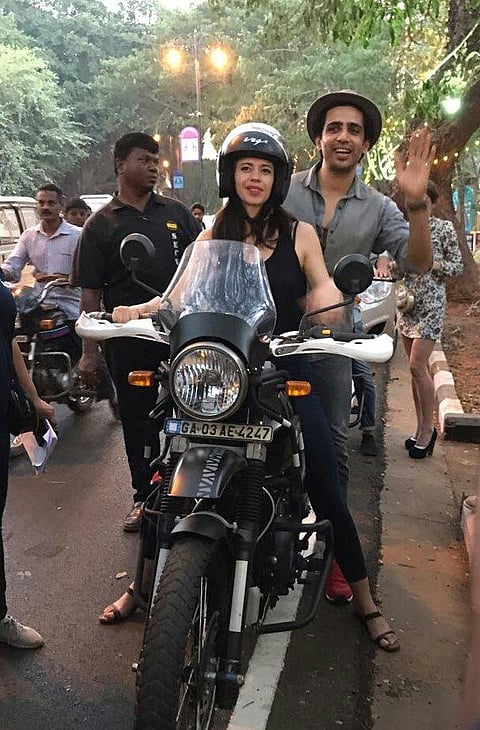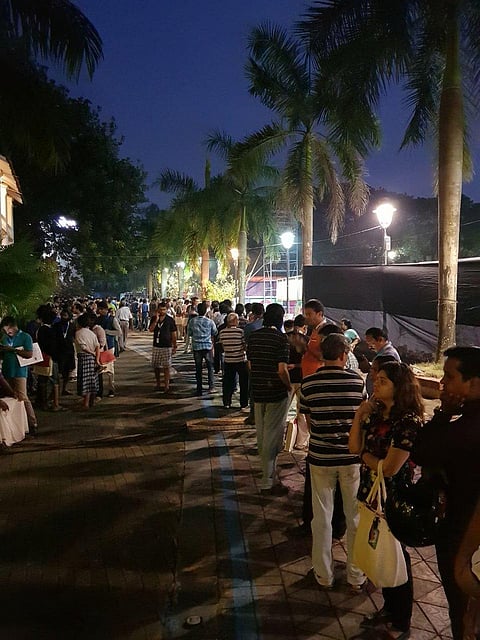Conspicuous by their absence – After the initial controversies regarding unceremonious exclusion of opening film of Indian Panorama “Nude” and S Durga, cinema lovers have been thronging the Kala Academy and screens at Inox to watch 195 films from 82 countries at the International Film Festival of India. There are some mainstream, ordinary movies and many more interesting films from all over the world. However, the discussion among the viewers, media fraternity and the delegates remains around the two films that are not screening. After watching films with explicit, graphic sexual content, some delegates asked a logical question – If so much nudity, often without significant context in films, is allowed just because it is a foreign film, how does a film dealing with upheavals in the life of a woman, who has to become a nude model for art students, is objectionable for viewing? The latest is that the festival director has asked Sanal Sasidharan to submit censored copy of S Durga, the screening is neither scheduled nor is anyone talking about any such possibility. However, amidst general lack of furore over bypassing the jury and curbing of freedom of expression, filmmakers have been raising this issue – for example Supriyo Sen at the time of introducing his documentary “Our Grandparents Home” on Partition, urged the audience passionately to resist such high-handed behavior from the government. So did director of Dashakriya, a Marathi film about the predatory economic cycle of last rites.
At The 48th International Film Festival Of India, Goa: Crash Course In Cinema, Stories And The Zombie Life

Crash course in cinema, stories and the zombie life – I started my festival with Mrinal Sen’s Khandar (the ruins) and since then have seen world cinema films such as Felicite, Mother!, A Ciambra, Loveless, documentaries such as Our Grandparents’ home, The Stairs and Zuzari and Marathi films such as Kshitij: A Horizon, Muramba, Kaasav and Kaccha Limbu. There is no method to this madness as we queue up depending on tickets that are available, passionate recommendations picked up from auto stands, cafetaria, press conferences, rush lines (queue for people who don’t have pre-booked seats) and personal favourites. Themes range from teenage angst, mother’s struggles to save her son, depression, breakdown of relationships, a Goan freedom fighter, drug addiction and mind-numbing ideas of creator and creation. There is also some mainstream Bollywood fair, such as Jolly LLB 2 (yeah, gasp!) but these are probably best left to weekend watching in our cities and no matter how twisted and tangled you feel after watching a Tarkovsky at mid-night, that is the point of attending a film festival such as this.

It all starts with a story: Afternoons at IFFI are meant for media interactions with various filmmakers and actors – national and international and apart from questions, which are actually long-winded opinions of veteran movie buffs and cinema experts, one does get some sparks once in a while. At one such meet, Rajesh Mapuskar, whose Ventilator drew great crowds and applause, spoke about the economics of making a film in Marathi and in Hindi (he specifically insisted on NOT calling it Bollywood!) and also why some stories ought to be told in local languages. While his infectious charm and patience dealt with some tedious questions with ease, Miransha Naik, a young Goan filmmaker, whose debut film Juze, has garnered tremendous praise from Goan and non-Goan cinema lovers all alike, lit up the atmosphere with his sincerity to cinema and irreverence to everything else including the government and systems. Bidyut Kutuky explained the challenges of making a film in Assamese, where, among other challenges, the number of theatres has reduced. The filmmakers spoke about the need for pan-Indian audience to watch regional films with subtitles, when audience was increasingly getting used to watching world cinema, in languages such as German, French, Iranian, Vietamese and so on. But the best moment was when all the dissection of technique, economics and choice of actors was done, when further dense discussion was expected on “what is it that one thing that a filmmaker must focus on?” Miransha swept it with, “What is not important while making a film? Every single element is. I don’t set out to send a message, if it happens, it’s okay. But when you want 500-1000 people to work on a film, it all starts with a story. It starts with a story…” Such brazen conviction and desperation for perfection in each element, was just pure joy.

Shhh, the food court is not in session… – At festivals such as these, the food court is usually a crowded place, which gives great business and profits to the local chefs and catering services. However, turns out the festival hasn’t turned out that well. When there was hardly any crowd at the food court even on the third day of the festival, some of the locals closed and shut their stalls, finding that whatever little crowd there was, it was headed to the stalls for Beer, Chaat, Parathas and Sandwiches in an enclosure that apparently was more accessible near the screens. Sagar, one of the helpers, who had come from Belgaum to help out his brother and also try his luck at the “film festival” says, “We tried for 2-3 days but despite this colourful shamiana, there was no foot fall.” And even at the other enclosure, the managers were ruing reduced attendance. However, none of this means that the food was priced reasonably or was delicious by any stretch of imagination. And in any case, when you are in Goa, you drink beer and beat the sun and then head to some traditional Goan cuisine places (if you are not watching your sixth film of the day at 1030 pm) for fish curry and feverish conversations about the films that were watched and next day’s schedule.

Tags